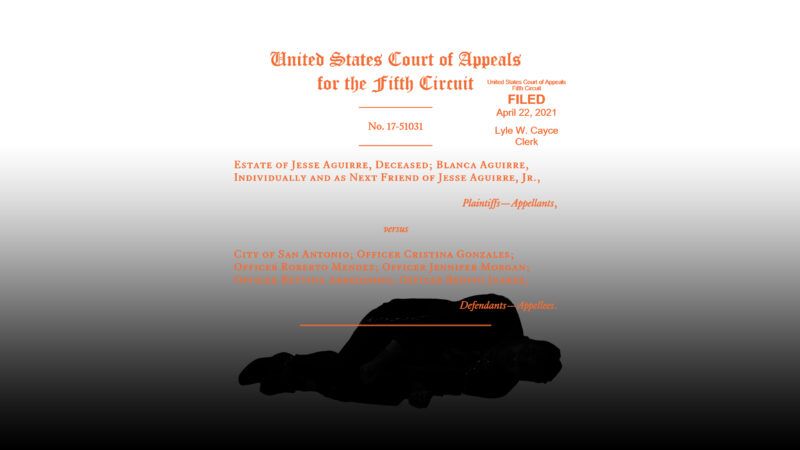Cops Who Killed a Man While Holding Him in a Hog-Tie Position Got Qualified Immunity. The Appeals Court Wasn't Having It.
Up for debate was whether or not it was "clearly established" that officers cannot apply injurious force to a subject who isn't resisting.

A group of police officers who hog-tied a man and held him face-down on pavement for five-and-a-half minutes, eventually resulting in his death from asphyxiation, are not entitled to qualified immunity and can thus be sued for damages, a federal court ruled last month.
The decision overturns a lower court ruling, which held that the family didn't have the right to bring any such suit before a jury. It's another example of just how subjective qualified immunity decisions can be, which often prohibit victims from holding state actors accountable in civil court when the misconduct they're alleging isn't outlined almost exactly somewhere in a previous court precedent.
On April 12, 2013, a man named Jesse Aguirre was seen walking near the median on a busy thoroughfare, prompting a response from San Antonio Police Department (SAPD) Officers Cristina Gonzales, Roberto Mendez, Jennifer Morgan, and Bettina Arredondo.
Gonzales, who was the first to arrive and who blocked off the eastbound left lane with her police cruiser, can be seen in the dash cam footage approaching Aguirre with her firearm pointed at him. "I'm going to shoot you, motherfucker," she threatened. Officers Morgan and Mendez came next, brandishing a gun and taser, respectively. Aguirre subsequently stopped walking and leaned down on the median, at which point Gonzales moved forward and handcuffed him. According to the dash cam footage, he did not resist, the decision notes.
After transporting Aguirre over the median and patting him down—he was unarmed—the officers placed him in the prone position face-down on the ground. Gonzales crossed his legs and leaned on them as she pushed them up toward his buttocks, while Mendez alternated between digging his knee into Aguirre's back and using his hand to press Aguirre's face into the pavement. Mendez—along with Officer Arredondo, who had recently arrived at the scene—held his arms and back.
Officer Benito Juarez, a medical tech, got to the scene after Aguirre had been subdued, "but the record does not disclose that Juarez offered any advice or assistance to the other Officers about the manner in which Aguirre was being held," the ruling says. Arredondo conceded that she noticed Aguirre's lips had turned a shade of blue, but she chalked it up to drug use.
After those five-and-a-half minutes passed, the cops observed he wasn't breathing. "At this point, the Officers appear to be in good spirits; according to the Plaintiffs, in the dashcam videos," the decision adds, "Juarez can be seen smiling as he jogs to his vehicle, and several other Officers likewise appear to be smiling and laughing as they await Juarez's return around Aguirre's body."
That infectious energy would soon fade as they unsuccessfully tried to revive him. An autopsy report classified the death as homicide by asphyxiation.
"It has long been clearly established that, when a suspect is not resisting, it is unreasonable for an officer to apply unnecessary, injurious force against a restrained individual, even if the person had previously not followed commands or initially resisted the seizure," wrote Judge James L. Dennis for the U.S. Court of Appeals for the 5th Circuit. "If the Officers unnecessarily placed Aguirre in the maximal-restraint position when there was no reason to believe he had committed a serious crime, that he posed a continuing threat to the Officers or public safety, or that he was resisting the Officers' seizure or holding of him, the Officers violated Aguirre's clearly established constitutional rights."
The cops dispute Aguirre's compliance. Dennis wasn't convinced. "This court's own review of the video evidence at minimum raise genuine questions about whether it was objectively reasonable to believe Aguirre was actively resisting," he wrote, "or even physically capable of posing an immediate safety threat." A police excessive force expert reached the same conclusion in sworn testimony.
Dennis makes the matter sound beyond debate—a welcome decision that will give Aguirre's estate a chance at accountability. But the doctrine of qualified immunity has become so granular that judges often side with government officials if plaintiffs aren't able to furnish a court precedent with almost exactly the same facts.
The 5th Circuit itself provides several interesting examples. Take Trent Taylor, who prison guards forced naked into two psychiatric unit cells that were in deplorable shape—one defaced in human feces, the other with a raw sewage leak on the floor. Though the federal court agreed that such treatment violated his Eighth Amendment rights, it barred him from suing because the exact amount of time he spent in those cells—six days—had not yet been enshrined somewhere in pre-existing case law.
Though the U.S. Supreme Court has shied away from fundamentally reconsidering qualified immunity, it has shown a willingness to make subtle moves on the doctrine as of late. That includes the above 5th Circuit decision, which the high court overturned in the fall. In February, so too did it reverse another 5th Circuit ruling, which had awarded qualified immunity to a prison guard who pepper-sprayed an inmate without provocation. Neither move from the Supreme Court altered qualified immunity itself. But if the 5th Circuit's decision in Aguirre is any indication, perhaps those gentler nudges are having some effect.


Show Comments (65)